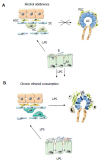Alcoholic pancreatitis: A tale of spirits and bacteria
- PMID: 24891979
- PMCID: PMC4025076
- DOI: 10.4291/wjgp.v5.i2.82
Alcoholic pancreatitis: A tale of spirits and bacteria
Abstract
Alcohol is a major cause of chronic pancreatitis. About 5% of alcoholics will ever suffer from pancreatitis, suggesting that additional co-factors are required to trigger an overt disease. Experimental work has implicated lipopolysaccharide, from gut-derived bacteria, as a potential co-factor of alcoholic pancreatitis. This review discusses the effects of alcohol on the gut flora, the gut barrier, the liver-and the pancreas and proposes potential interventional strategies. A better understanding of the interaction between the gut, the liver and the pancreas may provide valuable insight into the pathophysiology of alcoholic pancreatitis.
Keywords: Alcohol; Bacteria; Endotoxin; Fibrosis; Lipopolysaccharide; Pancreatitis.
Figures

Similar articles
-
Mechanisms of alcoholic pancreatitis.J Gastroenterol Hepatol. 2010 Dec;25(12):1816-26. doi: 10.1111/j.1440-1746.2010.06445.x. J Gastroenterol Hepatol. 2010. PMID: 21091991 Review.
-
Bacterial endotoxin: a trigger factor for alcoholic pancreatitis? Evidence from a novel, physiologically relevant animal model.Gastroenterology. 2007 Oct;133(4):1293-303. doi: 10.1053/j.gastro.2007.06.062. Epub 2007 Jul 3. Gastroenterology. 2007. PMID: 17919500
-
New insights into alcoholic pancreatitis and pancreatic cancer.J Gastroenterol Hepatol. 2009 Oct;24 Suppl 3:S51-6. doi: 10.1111/j.1440-1746.2009.06071.x. J Gastroenterol Hepatol. 2009. PMID: 19799699 Review.
-
Genotypes of alcohol-metabolizing enzymes in relation to alcoholic chronic pancreatitis in Japan.Alcohol Clin Exp Res. 1999 Apr;23(4 Suppl):85S-91S. doi: 10.1111/j.1530-0277.1999.tb04541.x. Alcohol Clin Exp Res. 1999. PMID: 10235286
-
Individual susceptibility to alcoholic pancreatitis.J Gastroenterol Hepatol. 2008 Mar;23 Suppl 1:S63-8. doi: 10.1111/j.1440-1746.2007.05287.x. J Gastroenterol Hepatol. 2008. PMID: 18336667 Review.
Cited by
-
Intestinal CYP2E1: A mediator of alcohol-induced gut leakiness.Redox Biol. 2014;3:40-6. doi: 10.1016/j.redox.2014.10.002. Epub 2014 Oct 19. Redox Biol. 2014. PMID: 25462064 Free PMC article. Review.
-
Altered mucosal bacteria and metabolomics in patients with Peutz-Jeghers syndrome.Gut Pathog. 2024 Apr 27;16(1):25. doi: 10.1186/s13099-024-00617-9. Gut Pathog. 2024. PMID: 38678229 Free PMC article.
-
Identification of early predictors for infected necrosis in acute pancreatitis.BMC Gastroenterol. 2022 Sep 3;22(1):405. doi: 10.1186/s12876-022-02490-9. BMC Gastroenterol. 2022. PMID: 36057565 Free PMC article.
-
Altered Gut Microbiota in Patients With Peutz-Jeghers Syndrome.Front Microbiol. 2022 Jul 13;13:881508. doi: 10.3389/fmicb.2022.881508. eCollection 2022. Front Microbiol. 2022. PMID: 35910641 Free PMC article.
-
Gut region-dependent alterations of nitrergic myenteric neurons after chronic alcohol consumption.World J Gastrointest Pathophysiol. 2015 Aug 15;6(3):51-7. doi: 10.4291/wjgp.v6.i3.51. World J Gastrointest Pathophysiol. 2015. PMID: 26301118 Free PMC article.
References
-
- Pace A, de Weerth A, Berna M, Hillbricht K, Tsokos M, Bläker M, Pueschel K, Lohse AW. Pancreas and liver injury are associated in individuals with increased alcohol consumption. Clin Gastroenterol Hepatol. 2009;7:1241–1246. - PubMed
-
- Bode C, Kugler V, Bode JC. Endotoxemia in patients with alcoholic and non-alcoholic cirrhosis and in subjects with no evidence of chronic liver disease following acute alcohol excess. J Hepatol. 1987;4:8–14. - PubMed
-
- Fukui H, Brauner B, Bode JC, Bode C. Plasma endotoxin concentrations in patients with alcoholic and non-alcoholic liver disease: reevaluation with an improved chromogenic assay. J Hepatol. 1991;12:162–169. - PubMed
-
- Bhagwandeen BS, Apte M, Manwarring L, Dickeson J. Endotoxin induced hepatic necrosis in rats on an alcohol diet. J Pathol. 1987;152:47–53. - PubMed
Publication types
LinkOut - more resources
Full Text Sources
Other Literature Sources

